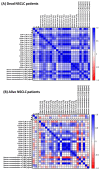Analysis of Selected Toll-like Receptors in the Pathogenesis and Advancement of Non-Small-Cell Lung Cancer
- PMID: 38792335
- PMCID: PMC11122486
- DOI: 10.3390/jcm13102793
Analysis of Selected Toll-like Receptors in the Pathogenesis and Advancement of Non-Small-Cell Lung Cancer
Abstract
(1) Background: Non-small-cell lung cancer (NSCLC) represents a significant global health challenge, contributing to numerous cancer deaths. Despite advances in diagnostics and therapy, identifying reliable biomarkers for prognosis and therapeutic stratification remains difficult. Toll-like receptors (TLRs), crucial for innate immunity, now show potential as contributors to cancer development and progression. This study aims to investigate the role of TLR expression as potential biomarkers in the development and progression of NSCLC. (2) Materials and Methods: The study was conducted on 89 patients diagnosed with NSCLC and 40 healthy volunteers, for whom the prevalence of TLR2, TLR3, TLR4, TLR7, TLR8, and TLR9 was assessed on selected subpopulations of T and B lymphocytes in the peripheral blood of recruited patients along with the assessment of their serum concentration. (3) Result: Our study showed several significant changes in NSCLC patients at the beginning of the study. This resulted in a 5-year follow-up of changes in selected TLRs in recruited patients. Due to the high mortality rate of NSCLC patients, only 16 patients survived the 5 years. (4) Conclusions: The results suggest that TLRs may constitute real biomarker molecules that may be used for future prognostic purposes in NSCLC. However, further validation through prospective clinical and functional studies is necessary to confirm their clinical utility. These conclusions may lead to better risk stratification and tailored interventions, benefiting NSCLC patients and bringing medicine closer to precision.
Keywords: biomarkers; clinicopathological characteristics; innate immune system; non-small-cell lung cancer; toll-like receptors; tumor progression.
Conflict of interest statement
The authors declare no conflicts of interest. The funders had no role in the study’s design or collection, analyses, or interpretation of data; in the writing of the manuscript; or in the decision to publish the results.
Figures









Similar articles
-
Expression profiles of Toll-like receptors in non-small cell lung cancer and idiopathic pulmonary fibrosis.Int J Oncol. 2012 May;40(5):1397-404. doi: 10.3892/ijo.2012.1374. Epub 2012 Feb 15. Int J Oncol. 2012. PMID: 22344343
-
Serum toll-like receptors are potential biomarkers of radiation pneumonia in locally advanced NSCLC.Int J Clin Exp Pathol. 2014 Oct 15;7(11):8087-95. eCollection 2014. Int J Clin Exp Pathol. 2014. PMID: 25550856 Free PMC article.
-
New Horizons in the Diagnosis of Gastric Cancer: The Importance of Selected Toll-like Receptors in Immunopathogenesis Depending on the Stage, Clinical Subtype, and Gender of Newly Diagnosed Patients.Int J Mol Sci. 2024 Aug 27;25(17):9264. doi: 10.3390/ijms25179264. Int J Mol Sci. 2024. PMID: 39273213 Free PMC article.
-
Differential Expression Patterns of Toll-like Receptors in COVID-19 Patients.Front Biosci (Landmark Ed). 2023 Nov 28;28(11):307. doi: 10.31083/j.fbl2811307. Front Biosci (Landmark Ed). 2023. PMID: 38062845 Review.
-
Human Toll-like receptor-dependent induction of interferons in protective immunity to viruses.Immunol Rev. 2007 Dec;220(1):225-36. doi: 10.1111/j.1600-065X.2007.00564.x. Immunol Rev. 2007. PMID: 17979850 Free PMC article. Review.
Cited by
-
Toll-Like Receptor 4 and 8 are Overexpressed in Lung Biopsies of Human Non-small Cell Lung Carcinoma.Lung. 2025 Mar 1;203(1):38. doi: 10.1007/s00408-025-00793-8. Lung. 2025. PMID: 40025339 Free PMC article.
References
Grants and funding
LinkOut - more resources
Full Text Sources
Miscellaneous

